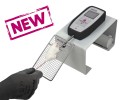Authors
C. Pin-Barre, J. Laurin, M.S. Felix, V. Pertici, F. Kober
Lab
Aix-Marseille Université, Marseille, France
Journal
PLOS One
Abstract
The purpose of the study was to highlight the acute motor reflex adaptation and to deepen functional deficits following a middle cerebral artery occlusion-reperfusion (MCAO-r). Thirty-six Sprague-Dawley rats were included in this study. The middle cerebral artery occlusion (MCAO; 120 min) was performed on 16 rats studied at 1 and 7 days, respectively (MCAO-D1 and MCAO-D7, n = 8 for each group). The other animals were divided into 3 groups: SHAM-D1 (n = 6), SHAM-D7 (n = 6) and Control (n = 8). Rats performed 4 behavioral tests (the elevated body swing test, the beam balance test, the ladder-climbing test and the forelimb grip force) before the surgery and daily after MCAO-r. H-reflex on triceps brachii was measured before and after isometric exercise. Infarction size and cerebral edema were respectively assessed by histological (Cresyl violet) and MRI measurements at the same time points than H-reflex recordings. Animals with cerebral ischemia showed persistent functional deficits during the first week post-MCAO-r. H-reflex was not decreased in response to isometric exercise one day after the cerebral ischemia contrary to the other groups. The motor reflex regulation was recovered 7 days post-MCAO-r. This result reflects an acute sensorimotor adaptation at the spinal level after MCAO-r.
BIOSEB Instruments Used:
Grip strength test (BIO-GS3)

 Pain - Thermal Allodynia / Hyperalgesia
Pain - Thermal Allodynia / Hyperalgesia Pain - Spontaneous Pain - Postural Deficit
Pain - Spontaneous Pain - Postural Deficit Pain - Mechanical Allodynia / Hyperalgesia
Pain - Mechanical Allodynia / Hyperalgesia Learning/Memory - Attention - Addiction
Learning/Memory - Attention - Addiction Physiology & Respiratory Research
Physiology & Respiratory Research
 Pain
Pain Central Nervous System (CNS)
Central Nervous System (CNS) Neurodegeneration
Neurodegeneration Sensory system
Sensory system Motor control
Motor control Mood Disorders
Mood Disorders Other disorders
Other disorders Muscular system
Muscular system Joints
Joints Metabolism
Metabolism Cross-disciplinary subjects
Cross-disciplinary subjects Preclinical studies and opioids: role in crisis management in the United States
Preclinical studies and opioids: role in crisis management in the United States 